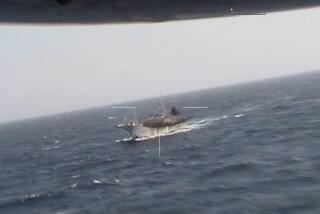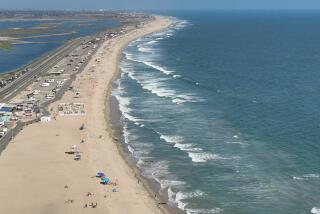Their Angle Is to Let the Big Ones Get Away
The old cliche about the fish that got away has taken on a new twist with today’s conservation-conscious fishermen, such as Bill Von Henkle.
For Von Henkle, the thrill is in the catching, not the killing. That’s why more and more anglers are hooking the big ones, then letting them get away--unharmed--so that future generations may hook them again.
This weekend, Von Henkle and about 75 other anglers will take part in Hoag Hospital’s billfish tournament, a fishing contest that encourages participants to release their catches.
Since the early 1960s, fishermen have been catching, tagging and releasing fish, thanks to conservation programs initiated by Woods Hole Oceanographic Institution in Massachusetts and the National Marine Fisheries Service, which is part of the U.S. Department of Commerce.
“Tagging and releasing fish has been around for a long time,” says Von Henkle, who estimates that he has caught and released more than 600. “In the last 10 years, most fishing tournaments have moved from being kill tournaments to release tournaments. Conservation has been the big factor in this. Probably 90% of the fishing tournaments today are release tournaments.”
One of the largest is a fund-raising tournament held each fall in Cabo San Lucas in Baja California. Von Henkle, co-founder of the Cabo tournament, expects this year’s competition to net about $400,000. “We’ve built a complete orphanage down there,” he says. Because of the success of the Cabo tournament, Von Henkle and a few other die-hard fishermen who are members of the Hoag Hospital men’s support group, the 552 Club, thought a local fishing contest might be a good way to raise money to benefit the hospital’s cancer center.
The sixth annual West Coast Marlin Shoot-Out, founded by Wanda Kipper (owner of Pacifica Yachts in Costa Mesa), raised $15,000 for the American Cancer Society three weeks ago and drew about 30 boats.
Von Henkle says the goal of the 552 tournament is $25,000, but that “it looks like we are going to raise more than that.”
The entry fee is $184 per line, said tournament Chairman Jay Reed, a longtime Orange County angler who, along with his wife, Marilyn, will be fishing off the family’s 38-foot powerboat. Fishing boundaries for the tournament are within a 70-mile radius of Newport Beach.
Both Reed and Von Henkle are pleased with the response to the hospital’s new fund-raising event. But one 552 member who was not able to enter is 78-year-old Horace Witherspoon, the man responsible for introducing the tag-and-release program to the West Coast. Witherspoon, who still fishes two or three times a week, had a prior commitment--he had already promised to take part in another tournament being held this weekend by the Tuna Club at Catalina Island.
But even though he won’t be fishing in the Hoag tournament, Witherspoon, who was successfully treated for cancer at Hoag Hospital 10 years ago, says he “wishes them the best.” The Kentucky-born Witherspoon, who caught his first billfish off the coast of Orange County in 1947, caught his most recent marlin last week while out fishing with his grandson.
As past president of the Tuna Club, the Balboa Angling Club and past chairman of the Pacific Area Cooperative Marine Game Fish Tagging Program, Witherspoon takes great pride in the tremendous growth of the local tag-and-release program.
“I started the tagging program here in 1962,” he says. “Conservation was my No. 1 reason. No one had any idea how many fish there were in the ocean and whether we were depleting them.”
But by tagging and releasing the fish, scientists, such as those at Woods Hole, could learn all about the fish’s life span, migratory route and decrease or increase in population, Witherspoon says.
“Since then, the program has expanded tremendously,” says Witherspoon, who says he remembers the first tagged marlin ever recovered in the Pacific. According to a newspaper clipping kept by Witherspoon, who was coordinating the tag-and-release program at the time, the fish was recovered in August, 1963, by a Japanese fishing vessel. It had been tagged by a woman in La Paz, Mexico, two months earlier and had traveled more than 1,000 miles during that time.
Locally, the tag-and-release effort is now run by the National Marine Fisheries Service in La Jolla. The program is part of the research carried out by laboratories throughout the United States to study game fish behavior. Billfish tags, yellow plastic streamers attached to stainless steel darts and inserted into the fish’s back near the dorsal fin, are available from the Fisheries Service and from some saltwater angling clubs and tackle stores.
Since the tag-and-release program began in the early ‘60s, about 200 tags have been recovered, said Jim Squire, who runs the Fisheries Service tagging program in La Jolla.
“The longest recorded billfish recovery in the world was in 1983,” Squire says. “A black marlin was tagged off the tip of Baja and 15 months later was caught north of New Zealand, 5,700 miles away.”
Sailing classes: You can learn to sail in a series of weekend classes being offered by the Dana Point Harbor Youth and Group Facility beginning today and continuing through Oct. 28. The hours are 9 a.m. to noon, and instruction is at the facility, at 34451 Ensenada Place. The cost is $45. For information call (714) 661-7122.
Women’s racing: The 10th annual Women’s Ocean Racing Series will be held today and Sunday in the ocean off Newport Beach. Activities will begin with a skipper’s meeting at 9 a.m. Saturday at the Balboa Yacht Club, 1801 Bayside Drive in Corona del Mar and will conclude with an awards ceremony at 7 p.m. Sunday at the Bahia Corinthian Yacht, Club, 1601 Bayside Drive, Corona del Mar. For information, call (714) 645-3700.
Sails and electronics: You can learn how to maintain your electronic gear or repair sails during two different marine classes offered by Orange Coast College beginning in October.
“Introduction to Marlinspike Seamanship” will teach participants how to maintain and repair their sails while at sea. The class, taught by Kern Ferguson, will be offered from 7 to 9 p.m. Mondays beginning next week and continuing through Nov. 27. The cost is $58.
“Small Boat Marine Electronics” is the subject of a class taught by Mark Upson beginning Thursday and continuing through Oct. 26. Hours are 7 to 9 p.m. The cost is $48. Both classes will meet at the college’s Sailing Center, 1801 W. Pacific Coast Highway, Newport Beach. For information call (714) 432-5880.
New officers: Harvey Wills, president of Western Marine Marketing in Santa Ana, has been elected president of the Southern California Marine Assn., a 900-member trade organization representing the recreational boating industry in California. The association, which puts on four major boat shows a year, is at 1006 E. Chapman Ave. in Orange. Elected to serve with Wills are Tom Frank of Warner Boat Sales in Costa Mesa, vice president; Barry Lieberman, Hardin Marine in Anaheim, secretary, and John Cordes of John Cordes Co. in Newport Beach, treasurer.
Shearlean Duke is a regular contributor to Orange County Life. On the Waterfront appears each Saturday, covering boating life styles as well as ocean-related activities along the county’s 42-mile coastline. Send information about boating-related events to: On the Waterfront, Orange County Life, The Times, 1375 Sunflower Ave., Costa Mesa, Calif. 92626. Deadline is two weeks before publication. Story ideas are also welcome.
More to Read
Sign up for Essential California
The most important California stories and recommendations in your inbox every morning.
You may occasionally receive promotional content from the Los Angeles Times.










